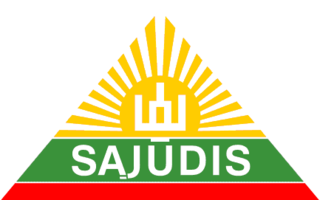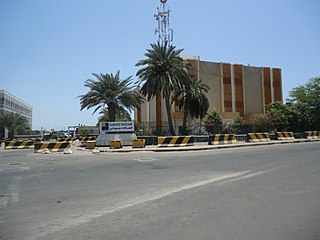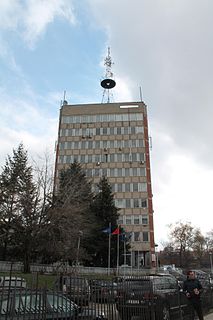Related Research Articles

Lithuania is a country on the south-eastern shore of the Baltic Sea, a member of the United Nations Organisation, the Organisation for Security and Cooperation in Europe, the European Union, the North Atlantic Treaty Organisation, the World Trade Organisation. Currently, Lithuania maintains diplomatic relations with 182 states Lithuania became a member of the United Nations on 18 September 1991, and is a signatory to a number of its organizations and other international agreements. It is also a member of the Organization for Security and Cooperation in Europe, NATO and its adjunct North Atlantic Coordinating Council, the Council of Europe, and the European Union. Lithuania gained membership in the World Trade Organization on 31 May 2001.

The Media of Poland consist of several different types of communications media including television, radio, cinema, newspapers, magazines, and Internet. During the communist regime in Poland the Stalinist press doctrine dominated and controlled Polish media. The country instituted freedom of press since the fall of communism. The Polish media system's main features are the product of the country's socio-political and economic post-communist transition. These features include: the privatisation of the press sector; the transformation of the state radio and television into public broadcasting services; influx of foreign capital into the media market and European integration of audiovisual media policies. Today the media landscape is very plural but highly polarized along political and ideological divides.
The media of Romania refers to mass media outlets based in Romania. Television, magazines, and newspapers are all operated by both state-owned and for-profit corporations which depend on advertising, subscription, and other sales-related revenues. The Constitution of Romania guarantees freedom of speech. As a country in transition, the Romanian media system is under transformation.
The media of Belarus are mass-media outlets based in Belarus. Television, magazines, and newspapers are operated by state-owned and for-profit corporations and depend on advertising, subscriptions, and other sales-related revenue. The Constitution of Belarus guarantees freedom of speech, but this is contradicted in practice by repressive and restrictive laws. Arbitrary detention, arrests, and harassment of journalists are frequent in Belarus. Anti-extremism legislation targets independent journalism, including material considered unfavourable to the president.

Australia has a modern and diverse media industry spanning traditional and digital formats, and catering mostly to its predominantly English-speaking population. In 2018 the Press Freedom Index ranked Australia 19th out of 180 countries

Sąjūdis, initially known as the Reform Movement of Lithuania, is the political organisation which led the struggle for Lithuanian independence in the late 1980s and early 1990s. It was established on 3 June 1988, and was led by Vytautas Landsbergis. Its goal was to seek the return of independent status for Lithuania.
The media of Georgia refers to mass media outlets based in the Republic of Georgia. Television, magazines, and newspapers are all operated by both state-owned and for-profit corporations which depend on advertising, subscription, and other sales-related revenues. The Constitution of Georgia guarantees freedom of speech. Georgia is the only country in its immediate neighborhood where the press is not deemed unfree. As a country in transition, the Georgian media system is under transformation.
Multiple forms of media including books, newspapers, magazines, films, television, and content published on the Internet are censored in Saudi Arabia.
Since 1991 Estonia has changed from being a former Soviet republic to a member of the European Union and the European Monetary Union, making a rapid transformation in several fields, including the media, which is a vibrant and competitive sector. For many years Estonia has been among the top ten in Reporters Without Borders’(RSF) Press Freedom Index. In 2017 it has been ranked 12th out of 180 countries by RSF while Freedom House assigned Estonia’s press freedom a score of 16/100. A cross-media landscape that embraces traditional media as well as the Internet and digital media characterises the contemporary media system in Estonia.
Latvia is one of the three post-Soviet Baltic states having regained independence in 1991 and since 2004 is a member State of the European Union. After its independence there have been fundamental changes of political, economic and social nature that have turned Latvia into a democratic country with a free market economy. This reflects on the media landscape which is considered well-developed despite being subjected to a limited market and a linguistic and cultural split between Latvian (58,2%) and Russian speakers (37,5%). In 2017 Freedom House defined Latvia's press freedom status as “free", assigning to the country's press freedom a score of 26/100. The 2017 World Press Freedom Index prepared annually by Reporters Without Borders (RSF) states that media in Latvia have a "two-speed freedom", underlying different levels of freedom for Latvian-language and Russian-language media. According to RSF's Index the country is ranked 28th among 180 countries.
In Slovakia, political information is disseminated through the mass media: television, radio, the press, and the internet. The public is becoming increasingly reliant on the internet for news, with television and the press becoming less important as news sources.
The Liberals Movement of the Republic of Lithuania, abbreviated to LRLS, is a conservative-liberal political party in Lithuania, the fourth most successful political party in 2016 parliamentary election.

Media in Djibouti is controlled by the government.

Ukraine is in 102nd place out of 180 countries listed in the 2017 World Press Freedom Index. Organizations like Reporters Without Borders, Human Rights Watch and Committee to Protect Journalists have condemned Poroshenko government recent bans on media.

The Media of Kosovo consists of different kinds of communicative media such as radio, television, newspapers, and internet web sites. Most of the media survive from advertising and subscriptions.
Media in Zambia consist of several different types of communications media: television, radio, cinema, newspapers, magazines, and Internet-based Web sites. The Ministry of Information, Broadcasting Services and Tourism is in charge of the Zambian News Agency which was founded in 1969.
Laos has one of the most restrictive media environments in the world. In 2016, Reporters Without Borders ranked Laos 173 out of 179 on its annual Press Freedom Index, behind countries such as Cuba and Iran.
Transparency of media ownership is the public availability of accurate, comprehensive and up-to-date information about media ownership structures. A legal regime guaranteeing transparency of media ownership makes possible for the public as well as for media authorities to find out who effectively owns, controls and influences the media as well as media influence on political parties or state bodies. The disclosure of media ownership can be prescribed by generic regulation or by media-specific provision. Such measures may mandate the disclosure of information on media ownership structures to specific authorities or to the general public.
Media ownership in Turkey is highly concentrated. According to experts, Turkish media ownership structure prevents citizens from receiving reliable information.
The Media of the Czech Republic refers to mass communication methods through broadcasting, publishing, and the Internet.
References
- 1 2 "Lithuania". Freedomhouse.org. Retrieved 8 November 2017.
- ↑ "Market & Opinion Research Centre "VILMORUS"". Vilmorus.lt. Retrieved 9 November 2017.
- 1 2 "The political (in)dependence of the media in Lithuania". Knm.uksw.edu.pl. Retrieved 8 November 2017.
- ↑ Irmina Matonytė, From Liberal to Predatory Mass Media in Post-Communist Lithuania, in Journalism Research, Science Journal (Communication and Information), 2009 N. 2, p. 168.
- ↑ "Lithuanian newspapers - True Lithuania". Truelithuania.com. Retrieved 8 November 2017.
- ↑ Virgis Valentinavičius, Deficit of Trust and the Decline of Print Media in Lithuania in Journalism Research. Science journal (Communication and information), 2016, N. 10, p. 5-6
- ↑ Auksė Balčytienė, Epp Lauk, Media Transformations: the Post-transition Lessons in Lithuania and Estonia, in Informacijos Mokslai, 2005, 33, p. 101
- ↑ "Internet Users by Country (2016) - Internet Live Stats". Internetlivestats.com. Retrieved 8 November 2017.
- ↑ Ainius Lašas, Behind the storefront of democracy: The case of media–politics relations in Lithuania, in Journalism 1–18 p. 15, 2017
- ↑ Auksë Balèytienë, Epp Lauk, Media Transformations:the Post-transition Lessons in Lithuania and Estonia 2005, p. 99.
- ↑ "Lithuania profile". Bbc.com. 20 April 2016. Retrieved 8 November 2017.
- ↑ Radio and Television Commission of Lithuania, 2016 Annual Report, p. 17-25. http://www.rtk.lt/content/uploads/2017/04/ENG-2016-m-LRTK-VEIKLOS-ATASKAITA-be-ataskaitu.pdf
- ↑ Alma Media divests BNS, https://www.almamedia.fi/en/media/releases/03-03-2014-alma-media-divests-bns
- ↑ "UAB"Respublikos investicija"". Stirna.info. Retrieved 8 November 2017.
- ↑ "LAW ON THE PROVISION OF INFORMATION TO THE PUBLIC" (PDF). E-seimas.lrs.lt. Retrieved 8 November 2017.
- ↑ "Text of Document". Litlex.lt. Retrieved 8 November 2017.
- ↑ "IX-2135 Law on Electronic Communications". 3.lrs.lt. Retrieved 8 November 2017.
- ↑ Emma Graham-Harrison; Daniel Boffey (3 April 2017). "Lithuania fears Russian propaganda is prelude to eventual invasion". Theguardian.com. Retrieved 8 November 2017.
- ↑ "Lithuania : Ban on Russian TV channels considered". Merlin.obs.coe.int. Retrieved 8 November 2017.
- ↑ "Lithuania". Freedomhouse.org. Retrieved 8 November 2017.
- ↑ "Freedom in the World 2016 Lithuania". Freedomhouse.org. Retrieved 9 November 2017.
- ↑ "Lithuanian media watchdog decides that LGBT rights video is harmful to children". en.delfi.lt. Retrieved 9 November 2017.
- ↑ "European Parliament resolution of 17 September 2009 on the Lithuanian Law on the Protection of Minors against the Detrimental Effects of Public Information". europarl.europa.eu. Retrieved 9 November 2017.
- ↑ "Lithuania". Freedomhouse.org. Retrieved 8 November 2017.
- ↑ "Journalists rally for press freedom in Lithuania". baltictimes.org. Retrieved 9 November 2017.
- ↑ "Lithuania Curtails the Media's Right to Criticize Politicians". liberties.eu. Retrieved 9 November 2017.
- ↑ Ainius Lašas, Behind the storefront of democracy: The case of media–politics relations in Lithuania, in Journalism 1–18 p. 8, 2017
- ↑ "In 2016 Lithuania's elected politicians and public servants owned 57 media outlets in Lithuania – Transparency International Lietuvos skyrius". Transparency.lt. Retrieved 8 November 2017.